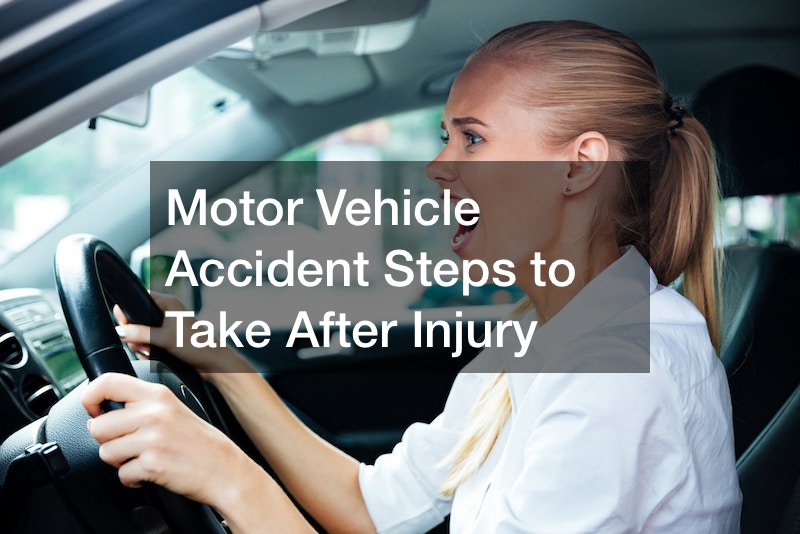
Motor vehicle accidents can cost you an arm and a leg. According to Centres for Disease Control and Prevention, Americans annually spend over one million days in the hospital due to road crash-related injuries. Additionally, there are about 2.5 million emergency department visits, which on average may cost about $3,300 over a person’s lifetime.
According to the Office of Highway Policy Information, car registrations surpass 270 million. That’s too many vehicles on American roads. While most car accidents are avoidable, the number of motor vehicle registrations increases your chances of getting involved in a road accident with a possible injury. In this case, what are the motor vehicle accident steps after an injury?
Any car accident will catch you by surprise, and you may get confused about what to do. For this reason, it’s better to know beforehand about the motor vehicle accident steps to take when injured. If you’re already in an accident scene, do not panic. Keep reading this article to know what you need to do.
Top Leading Causes Of Road Accidents
Road accidents are generally expensive. While some may cause you to schedule an appointment with a cosmetic dentist for reconstructive dentistry services, others may force you to go for in home physical therapy or expensive back pain treatment – depending on your injury.
It’s better to avoid accidents than to manage them. Also, knowing the motor vehicle accident steps to take when involved in an accident is equally essential. For this reason, for your awareness, the following are the leading causes of road accidents.
Distracted Driving

According to Centres for Disease Control and Prevention, about nine people in the US succumb to road crashes that involve a distracted driver daily. Therefore, distracted driving is arguably the leading cause of vehicle road accidents.
Most people think a driver can only be distracted when using their mobile phones. This statement is further from the truth. While it is a significant concern, the following are the main types of distractions:-
-
- Cognitive distraction: Completely taking your mind off the road when driving
-
- Visual distraction: When your eyes are completely off the road when driving
-
- Manual distraction: Physically taking your hands off the wheel while on the road.
Driving When Intoxicated
While driving while intoxicated may not be the number one cause of road accidents, it’s the most fatal. According to Centres for Disease Control and Prevention, about 29 people in the US succumb to alcohol-impaired driving daily, which means a person dies after every 50 minutes.
It’s deadly to drive when intoxicated, but you have to know that intoxication isn’t from alcohol alone; some drug prescriptions may be intoxicants. Always ensure you are under zero influence when behind the wheel; when unsure, it’s wise to get someone else in the driver’s seat.
Over-Speeding
Over-speeding will get you in a road accident, which mostly turns fatal. According to the United States Department of Transportation reports, in 2020 alone, speeding caused over about 11,258 fatalities.
Although you may be tempted to add on speed occasionally, it is advisable to observe the speed limits faithfully to save your life and your passengers.
Careless Driving
Don’t know when driving recklessly? If you have one of the following behaviors on the road, consider yourself a reckless driver who’s a potential candidate for a road accident.
-
- Speeding your car over the limit
-
- Aggressive behavior on the road (engaging in road rage)
-
- Changing lanes excessively
When upset, it is advisable to calm yourself down before getting behind the wheel, especially if you have a short temper. Don’t attempt to drive while overtaken by your anger to avoid injury or costly auto repair. Drive safely and avoid the unnecessary hustle of finding a qualified physician from the cosmetic dentists pool. A cosmetic dentist will be able to get you your smile back.
Sometimes, accidents can be unavoidable. In this case, apply the following essential motor vehicle accident steps to guide you on your next move when injured.
Critical Motor Vehicle Accident Steps To Take in Incase Of An Injury
Whenever you get involved in a car accident, the following are essential motor vehicle accident steps you may want to take to ensure everybody is safe, you’re on the right side of the law, and kick-start the insurance claiming process.
1. Stay On The Scene

Whether you’re involved in a minor or major road accident, do not attempt to leave the accident scene. As a driver, you’re required to know your legal rights and responsibilities. Leaving the scene may lead to potential criminal charges. Also, you may be liable for any financial damages.
In the case of a hit-and-run scenario, it isn’t wise to pursue the culprit as you could endanger yourself or the passengers. Instead, it would help to do the following:-
-
- Pull yourself over to avoid any incoming traffic
-
- Try to memorize important information, such as the car description
-
- Take note of the time and the accident’s location
-
- Check for any possible accident witnesses
2. Inspect Your Injury
Inspecting your injury is equally important among other critical motor vehicle accident steps. However minor the car accident may seem, your safety should be your priority. Chances are that your mental state will be in shambles, which is expected due to high levels of anxiety, but it is wise to check on your physical well-being by doing the following:-
-
- Move your head gently to check any slightest pain in your neck or head
-
- Visually inspect your legs and arms for blood, pain, or warmth feeling
In case of severe injury, do not move an inch and contact the authorities immediately. Primarily, moving may increase the damage, forcing you to go for orthopedic surgery. If you want to avoid such a scenario, staying still is advisable.
After ensuring you’re physically okay, inspect your passengers, if any, in the same measure. If they’re okay, proceed to the other car to check their well-being. In case of severe injury or unresponsiveness of passengers, contact the authorities immediately.
3. Dial 911

Most states require you to call the authorities as part of mandatory motor vehicle accident steps, especially in case of injury or if the damage exceeds a certain amount set by the state (usually about $1,000, it may be less in some states).
A police officer can help you with valuable information in a confusing situation – which often happens during an accident. Also, an effective officer will do the following:-
-
- Conduct quick investigations on what may have caused the accident
-
- In case the officer notices severe injuries, they’ll call for emergency care immediately
An officer will likely question everybody involved in the accident and create a report. If you are not at fault, and the other driver is responsible for the accident, in this case, the presence of police will prove beneficial. If possible, it will help to get the police report number and the responding officer’s badge number.
4. Move Your Vehicle, If You Can
In case of a minor accident with less severe injury, and also finding out who’s at fault, it makes sense to move the vehicles over to a shoulder away from traffic. Doing so will help avoid any traffic build-up that may delay accident responders from reaching the accident scene timely.
However, it isn’t wise to move the vehicles if:-
-
- There’s substantial debris on the road due to the accident
-
- If the car is not running correctly or totaled
A car accident is a possible crime scene, especially when a driver flees the scene or is driving under the influence of drugs. For this reason, you must judge with clear reasoning whether or not to move the vehicles.
5. Exchange Contact & Insurance Information

After ensuring no party has no injury, among many other motor vehicle accident steps, you’ll need to exchange insurance and contact information with the other driver. While doing so, ensure you capture the most critical information, such as:-
-
- Insurance company information and accurate policy number
-
- Capture the full names correctly and any other valid contact details
-
- Document the model, type, and color of the car
It is advisable to avoid any argument about whose fault it was when discussing the facts with the other driver. After filing your insurance claim, the adjuster responsible for it will conclude who initiated the accident after carefully examining the vehicles, reviewing witnesses’ information, and other supporting documentation such as the scene’s photographs and the police report.
6. Gather Evidence, If You Can
After identifying potential witnesses, the next critical step is to gather as much evidence as you can from the scene of the accident. To do so, you’ll need to document the following information.
-
- The car’s in-depth information, such as license plate number
-
- Take a picture of the car damage
-
- Take a picture of the traffic signals
-
- Take a picture of the skid marks, plus the condition of the area
When you notice a road sign lying down or missing, take a picture and keep it; it may be helpful when claiming insurance coverage. Such information will help solve the liability puzzle quickly.
7. Note Down What Happened; if You Can
When anxiety dies down and you find a relaxed and quiet moment, write down what happened. You’ll need to give as many details as possible and also document essential information such as:
- Your driving direction when the accident happened
- The exact location, date, and time of the accident
- Note down what you were doing at the exact moment of the impact
- Note down what the other car was doing at the time of the impact
You’ll need to write the information as best as you can remember and as accurately as possible. Keep the info accessible when required.
8. Notify Your Car Insurance Company
Contact your insurance company to report the accident. You also can call your insurance agent to report the accident on your behalf, but you have to be ready with facts to answer some critical questions.
It is critical to notify your car insurance company immediately; most insurance policies demand it. Failure to which you will jeopardize your coverage.
Most car insurance policies will cover personal injury protection and pay any primary care clinic bills related to your accident. You may not necessarily need to approach a medical insurance company for such coverage.
9. File Accident Report With the Department Of Motor Vehicles
You may be required to file an accident report with the Department of Motor Vehicles (DMV), which entirely depends on your area of residence and the accident’s severity.
Different states have varying reporting criteria. For this reason, it is vital to check how your state works and when you are needed to file an accident report with the DMV.
10. Contact A Lawyer
Lastly, among the vital motor vehicle accident steps to take after an injury, never forget to contact a lawyer, especially after severe injury or substantial property damage. A lawyer will guide you through all the legal aspects of the accident for your benefit.
Before signing anything from the other driver’s lawyer or insurance company, it’s always wise to let your lawyer go through the documentation for advice and directions.
In Summary
Motor vehicle accidents are generally expensive, and whenever you find yourself in a car accident with sustained injuries, there are a few vital motor vehicle accident steps you should consider taking immediately. The steps include staying on the scene, inspecting your injury, alerting the authorities, and moving your vehicle aside to prevent the building up of traffic.
While some accidents may be unavoidable, it is essential to take precautions that will help you evade any chances of getting involved in one, such as avoiding driving when intoxicated, distractions when behind the wheel, and speeding at all costs. Drive safe.


